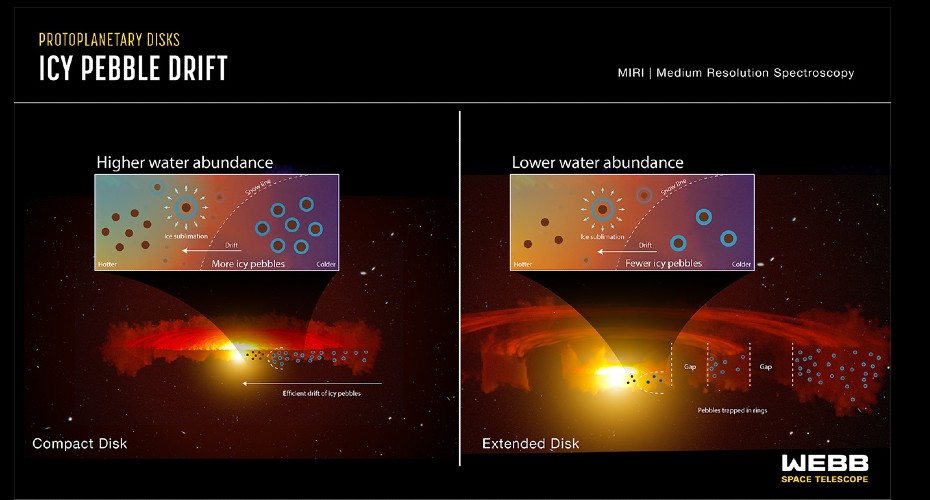NASA’s Webb Findings Support Long-Proposed Process of Planet Formation

This graphic is an interpretation of data from Webb’s MIRI, the Mid-Infrared Instrument, which is sensitive to water vapor in disks. It shows the difference between pebble drift and water content in a compact disk versus an extended disk with rings and gaps. In the compact disk on the left, as the ice-covered pebbles drift inward toward the warmer region closer to the star, they are unimpeded. As they cross the snow line, their ice turns to vapor and provides a large amount of water to enrich the just-forming, rocky, inner planets. On the right is an extended disk with rings and gaps. As the ice-covered pebbles begin their journey inward, many become stopped by the gaps and trapped in the rings. Fewer icy pebbles are able to make it across the snow line to deliver water to the inner region of the disk. Credit: NASA, ESA, CSA, Joseph Olmsted (STScI)
The quest to gain a greater understanding of how planets are formed has made a new significant breakthrough, thanks to new research using NASA’s James Webb Space Telescope.
A team of international scientists, including Sebastiaan Krijt from the University of Exeter, have shown that icy pebbles that form in the cold, outer regions of protoplanetary disks could play a fundamental role in terrestrial planet formation.
By observing water vapor in protoplanetary disks through the Webb telescope, the team were able to confirm a physical process involving the drifting of ice-coated solids from the outer regions of the disk into the rocky-planet zone.
Theories have long proposed that icy pebbles forming in the outer regions of protoplanetary disks — the same area where comets originate in our solar system —should drift inward toward the star due to friction in the gaseous disk, delivering both solids and water to planets.
A fundamental prediction of this theory is that as icy pebbles enter into the warmer region within the “snowline” — where ice transitions to vapor — they should release large amounts of cold water vapor – which has been observed through the Webb telescope.
Sebastiaan Krijt from the University of Exeter and co-author of the study said: “I am in awe of the performance of JWST and the ability of Andrea, Colette, and the many other experts on the team to make sense of this rich and at times puzzling dataset.
“Pebbles play a huge role in modern planet formation theory, with the ways in which they grow, move, and are accreted by growing planets all influencing the final outcome. To be able to now see signs of how drifting pebbles shape the chemical environment of the inner disk regions, where small temperate worlds may be forming, is absolutely fascinating.”
Principal investigator Andrea Banzatti of Texas State University, San Marcos, Texas added: “Webb finally revealed the connection between water vapor in the inner disk and the drift of icy pebbles from the outer disk. This finding opens up exciting prospects for studying rocky planet formation with Webb!”
“In the past, we had this very static picture of planet formation, almost like there were these isolated zones that planets formed out of,” explained team member Colette Salyk of Vassar College in Poughkeepsie, New York. “Now we actually have evidence that these zones can interact with each other. It’s also something that is proposed to have happened in our solar system.”
The researchers used Webb’s MIRI (the Mid-Infrared Instrument) to study four disks — two compact and two extended — around Sun-like stars. All four of these stars are estimated to be between 2 and 3 million years old, just newborns in cosmic time.
The two compact disks are expected to experience efficient pebble drift, delivering pebbles to well within a distance equivalent to Neptune’s orbit. In contrast, the extended disks are expected to have their pebbles retained in multiple rings as far out as six times the orbit of Neptune.
The Webb observations were designed to determine whether compact disks have a higher water abundance in their inner, rocky planet region, as expected if pebble drift is more efficient and is delivering lots of solid mass and water to inner planets. The team chose to use MIRI’s MRS (the Medium-Resolution Spectrometer) because it is sensitive to water vapor in disks.
The results confirmed expectations by revealing excess cool water in the compact disks, compared with the large disks.
As the pebbles drift, any time they encounter a pressure bump — an increase in pressure — they tend to collect there. These pressure traps don’t necessarily shut down pebble drift, but they do impede it. This is what appears to be happening in the large disks with rings and gaps.
Current research proposes that large planets may cause rings of increased pressure, where pebbles tend to collect. This also could have been a role of Jupiter in our solar system — inhibiting pebbles and water delivery to our small, inner, and relatively water-poor rocky planets.
When the data first came in, the results were puzzling to the research team. “For two months, we were stuck on these preliminary results that were telling us that the compact disks had colder water, and the large disks had hotter water overall,” remembered Banzatti. “This made no sense, because we had selected a sample of stars with very similar temperatures.”
Only when Banzatti overlaid the data from the compact disks onto the data from the large disks did the answer clearly emerge: the compact disks have extra cool water just inside the snowline, at about ten times closer than the orbit of Neptune.
“Now we finally see unambiguously that it is the colder water that has an excess,” said Banzatti. “This is unprecedented and entirely due to Webb’s higher resolving power.”
The team’s results appear in the Nov. 8 edition of the Astrophysical Journal Letters.
The James Webb Space Telescope is the world’s premier space science observatory. Webb is solving mysteries in our solar system, looking beyond to distant worlds around other stars, and probing the mysterious structures and origins of our universe and our place in it. Webb is an international program led by NASA with its partners, ESA (European Space Agency) and the Canadian Space Agency.



